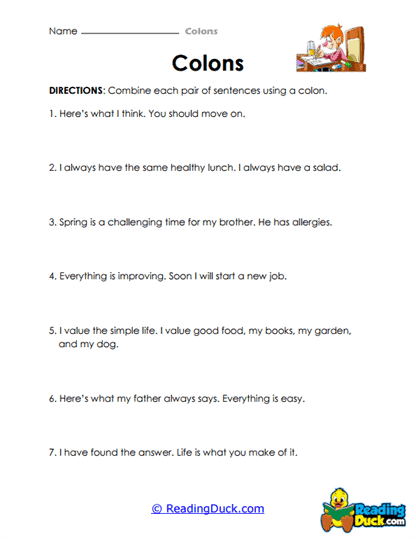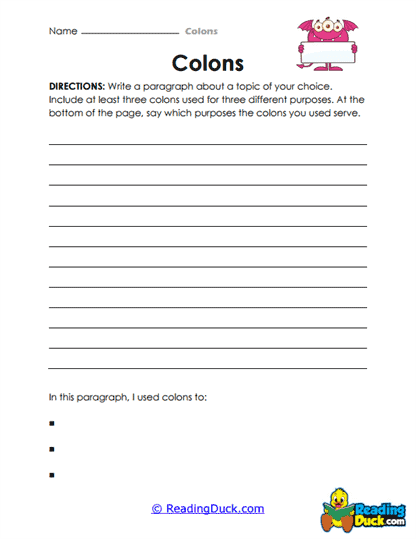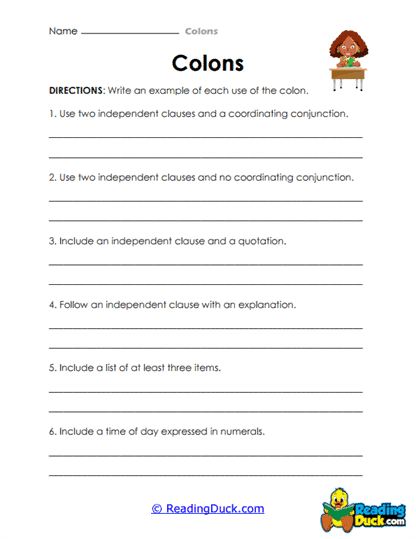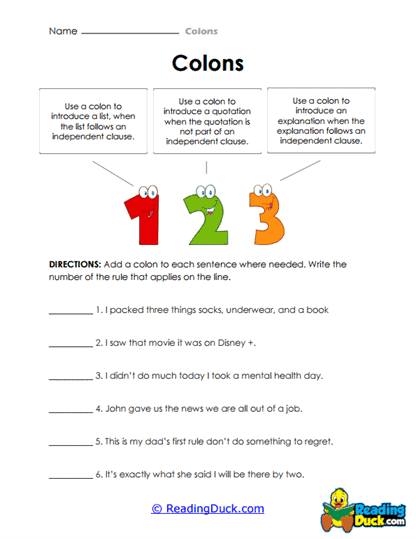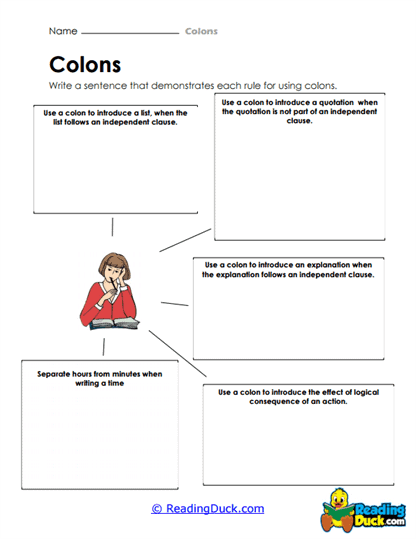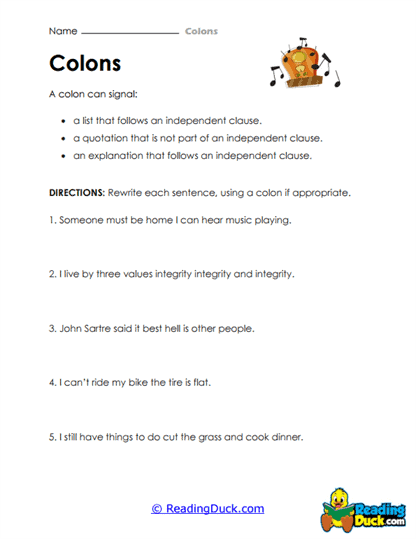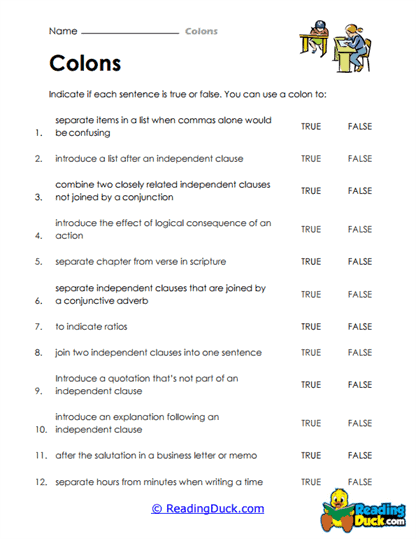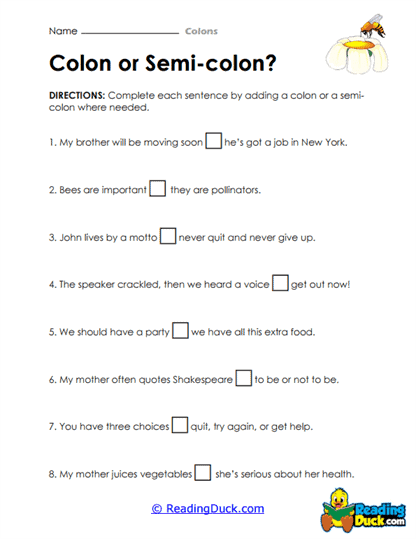Colons Worksheets
About Our Colon Worksheets
Our collection of Colons Worksheets serves as a vital educational resource for students to develop their punctuation skills, specifically focusing on the correct use of colons in writing. Falling under the Punctuation category within the broader Skills section, these worksheets offer clear and structured exercises designed to help learners understand and apply the rules of using colons accurately. Mastery of colons not only enhances students’ ability to structure their writing more effectively but also improves their overall communication skills by fostering clarity and precision.
The worksheets are presented in PDF format, making them simple to view, download, and print, ensuring flexibility and convenience for both classroom and homeschool environments. Each worksheet is accompanied by a downloadable answer key, providing immediate feedback for learners. This not only supports independent learning but also makes it easier for educators to monitor progress and offer guidance where necessary.
Understanding Colons: A Comprehensive Explanation
Colons are a powerful punctuation tool used to introduce and clarify information in a sentence. Unlike other punctuation marks, such as commas or periods, the colon carries a specific purpose, often signaling to the reader that what follows is directly related to what precedes it. Understanding how and when to use a colon is an essential skill for students as they advance their writing abilities and learn to communicate more clearly and effectively.
What Are Colons?
A colon (:) is a punctuation mark that introduces additional information, emphasizes key points, or lists examples that are relevant to the preceding statement. The colon acts as a bridge between two related ideas, signaling that the information following the colon elaborates or explains what came before.
The Basic Functions of Colons
Colons serve a few specific functions in writing:
Introducing a List: Colons are often used to introduce a list, especially when the list is a direct result or elaboration of the preceding sentence.
-
- Example: She packed everything she needed for the trip: sunscreen, a hat, snacks, and a book.
Elaboration or Explanation: A colon can also be used to introduce a further explanation or clarification of the previous statement.
-
- Example: He made one thing clear: honesty is always the best policy.
Emphasis: Colons are used to emphasize a particular point, drawing attention to what follows.
-
- Example: There is one rule you should never forget: always double-check your work.
Learning to recognize when a colon is needed in a sentence and applying it properly helps students create stronger, more organized sentences.
Different Ways to Use Colons in Writing
Colons serve multiple purposes in written communication, making them a versatile tool for creating structure and clarity. Below are some of the key ways that colons are used, with examples illustrating each use.
1. Colons for Lists
One of the most common uses of a colon is to introduce a list of items. A colon is placed after an independent clause (a complete sentence), followed by a list that elaborates or explains the idea presented in the first part of the sentence.
- Example: There are three things you need for the meeting: a notepad, a pen, and a positive attitude.
This use of colons helps break down complex information into an easy-to-follow format, making it more digestible for readers.
2. Colons to Introduce Explanations or Clarifications
Colons can be used to introduce an explanation or clarification of the preceding statement, adding more detail or resolving ambiguity.
- Example: She had one concern: the project was behind schedule.
In this case, the colon functions as a bridge between the main idea and the elaboration that follows, ensuring the reader fully understands the significance of the statement.
3. Colons for Emphasis
Writers often use colons to create emphasis, drawing attention to a particular word or phrase that is important within the context of the sentence.
- Example: Remember this rule: never skip proofreading.
Here, the colon highlights the importance of the rule, ensuring that the reader focuses on the key point being made.
4. Colons in Formal Writing
In formal writing, colons are used to introduce quotations, particularly in academic or professional contexts. They are also used after salutations in formal letters.
- Example (Quotation): The professor stated: "Critical thinking is essential for success in academia."
- Example (Salutation): Dear Sir or Madam:
The formal use of colons in writing helps maintain a structured and polished tone, ensuring that communication is clear and professional.
The Importance of Colons in Developing Literacy Skills
The correct use of colons plays a significant role in the development of students' literacy skills, especially as they progress into more advanced stages of writing and communication. Understanding how to use colons effectively supports their growth as readers, writers, and speakers.
Clarity in Writing
Colons help students organize their ideas in a logical, structured manner, making their writing more accessible and easier to understand. Whether introducing lists or providing explanations, the use of colons ensures that sentences are clear and concise, allowing the reader to follow the writer’s thoughts without confusion.
Enhancing Reading Fluency
When students encounter well-punctuated texts, their reading fluency improves. Understanding the function of colons allows students to anticipate what comes next—whether it is a list, an explanation, or an important point—which helps them process information more efficiently.
Better Communication Skills
By mastering the use of colons, students learn to communicate their ideas with greater precision. This skill translates into stronger speaking abilities as well, as students become more adept at structuring their thoughts in a logical, clear order. Using colons in written work also enhances the professionalism of their communication, which is essential for academic and future career success.
Interactive Activities for Learning Colons
To reinforce the rules and uses of colons, educators can engage students in various activities that promote active learning. These activities can be adapted for different grade levels and can be used both in school and in a homeschool setting to make learning punctuation more engaging and effective.
Activities for Elementary Grades (Grades 4-5)
- Colon Sorting Game: Present students with sentences that are missing punctuation marks. Ask them to decide where a colon should be placed and then write out the corrected sentences. This helps students practice identifying when colons are needed in a fun, interactive way.
- List Creation: Have students write a sentence that introduces a list using a colon. Then, ask them to expand the sentence with a variety of items that fit into the list. This helps them practice using colons to organize information.
Activities for Middle School (Grades 6-8)
- Colon in Context: Provide students with paragraphs where colons could be used, but are not present. Ask them to revise the text by adding colons where appropriate, helping them apply their understanding of colons in a more complex context.
- Creative Writing Challenge: Ask students to write short stories or essays that include at least five sentences with colons. This encourages them to think creatively while practicing the punctuation rules they’ve learned.
Homeschool Ideas
- Colon Scavenger Hunt: During reading time, ask students to find examples of colons in books, articles, or other texts. This reinforces their understanding of colons in real-world writing and helps them become more familiar with punctuation in context.
- Family Recipe List: Have students create a recipe that introduces a list of ingredients using a colon. This activity brings real-life relevance to their learning while reinforcing the rules of punctuation.
The Value of Colons as a Writing Skill
In summary, colons are an important tool in written communication, helping students convey information clearly and effectively. Our Colons Worksheets offer a comprehensive resource for mastering this punctuation mark, allowing students to apply the rules of colons in various contexts. Learning to use colons properly enhances both writing clarity and reading fluency, and contributes to stronger overall communication skills.
By integrating these worksheets into their learning process, students develop an essential skill that will serve them well throughout their academic careers and beyond. Colons may seem simple, but their proper use has a profound impact on the clarity and professionalism of writing. Understanding when and how to use colons ensures that students can communicate their thoughts with precision and impact, a skill that is invaluable in any form of writing or speaking.
